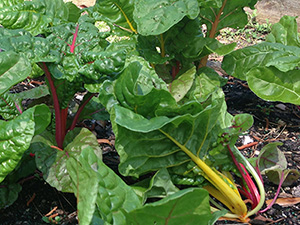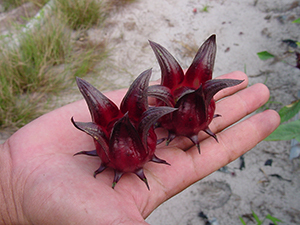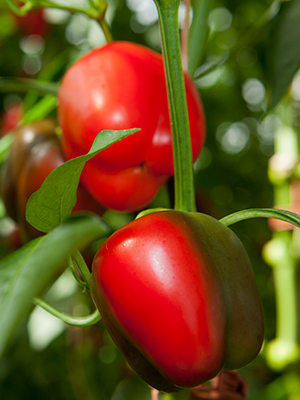Seeing Red: Fruit, Herbs, and Vegetables
If the color red plays an important role in your landscape, why not carry that through into your fruit or vegetable garden? And red vegetables are full of important nutrients like lycopene, which may play a role in preventing health problems like cancer¹. There are a handful of edible plants that can bring red into your landscape throughout the year.

Swiss chard comes in a variety of colors.
Cool-Season Edibles
Many of your favorite leafy green vegetables can be found in red or burgundy varieties. Swiss chard offers by far the widest choice of colors—not only red, but yellow and orange as well. Cultivars like 'Red Magic'', and 'Ruby Red' supply gardeners with green leaves and red stalks; the cultivar 'Peppermint' has unusual red and white stalks. Or get really colorful with 'Bright Lights', 'Five Color Silverbeet', or 'Neon Lights'—these seed mixes produce a rainbow of reds, pinks, yellows, and oranges. Red-leaf lettuces like ‘Red Sails’ and red romaine start out green and then turn to a lovely bronze-red color.
Basil can be planted the spring or the fall and is a versatile herb to have around. Red basil is a great option for adding a touch of burgundy-red to your herb or vegetable garden, and your meals. This Thai variety has a spicier flavor than typical green basil. And while sweet varieties of basil are often plagued with downy mildew, red basil have been found to be less susceptible.
Roselle is related to hibiscus and okra, and was once a popular edible that is gaining a bit more attention again. The red calyces of the roselle flower (similar to rose "hips") can be used to make a variety of jams and sauces, and it's the main ingrediant in "Red Zinger" tea.

Roselle calyces
Strawberries are a lot of fun to grow, and even more fun to eat. If you're interested in growing these sweet red fruits, keep in mind the relatively short planting window in fall. Gardeners in North Florida can plant between September 15–October 15, those in Central Florida between September 25–October 25, and South Florida gardeners can plant between October 1 until the first of December. February and March are the peak havesting months for Florida strawberries.
Warm-Season Edibles
Of course, when you think of red in the vegetable garden, tomatoes are often the first thing to come to mind. They're one of the most popular vegetables for growing at home and can be planted in the landscape or a container. From big beefsteak tomatoes to tiny cherry varieties, there is likely a red tomato right for you.
Peppers are another popular way to bring bright red color into the edible garden. From sweet bell peppers to hot chilies, and even ornamental peppers, these vegetables can give you a variety of flavors and hues for your landscape.
Okra can be polarizing (people seem love or hate this unique vegetable), what isn’t as debatable is how lovely this hibiscus relative can be in the landscape. When other plants are struggling in the heat, okra varieties like ‘Alabama Red’ and ‘Burgundy’ can offer bold, red foliage to brighten up your summer vegetable garden.

Red bell peppers. Photo by Tyler Jones, UF/IFAS.
More on Gardening Solutions
More on Nutrition
Donaldson, M. S. (2004). Nutrition and cancer: A review of the evidence for an anti-cancer diet. Nutrition Journal, 3, 19. http://doi.org/10.1186/1475-2891-3-19

